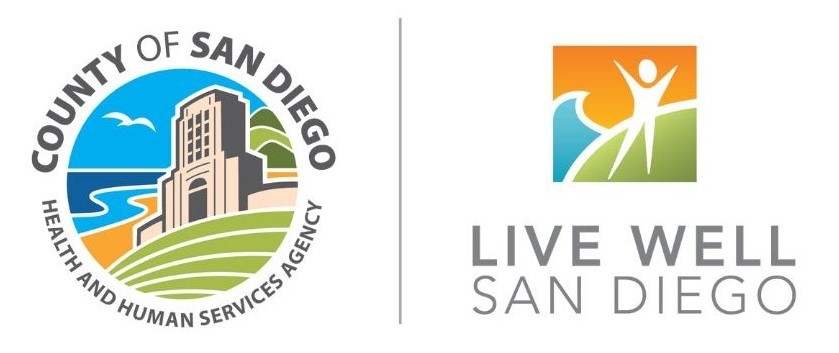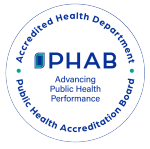Maps and Spatial Data
The Community Health Statistics Unit utilizes geographic information systems as a way to help planners, community partners, and the public visualize a variety of data spatially.
*Note: Map above depicts our Health and Human Services Agency regions, one of the many geographic boundaries we depict data in.

These atlases show rates of disease and injury mapped by community (Sub-regional Area, SRA) for all residents by medical outcome or death.* Indicators include non-communicable (chronic) disease, communicable disease, injury, and behavioral health conditions. Where available, maps by race-ethnicity and age group are included.
* Atlases may include rates of death, emergency department discharge, hospitalization, and in-patient treatment.
- Acute Alcohol Poisoning
- Acute Myocardial Infarction
- Alcohol Use/Abuse/Dependency
- All Drug Overdoses
- All Opioid Overdoses
- Alzheimer’s Disease
- Anxiety and Fear-related Disorders
- Assault/Homicide
- Asthma
- Cannabis Use/Abuse/Dependency
- CHD
- Chronic Alcohol Consumption
- Chronic Kidney Disease
- Chronic Kidney Disease Due to Diabetes
- Colorectal Cancer
- COPD/Chronic Lower Respiratory Diseases
- COVID-19
- Depression
- Diabetes
- Disorders of the Teeth and Jaw
- Falls
- Flu/Pneumonia
- Heart Failure
- Hip Fractures
- Kidney Cancer
- Leukemia
- Liver Cancer
- Lung Cancer
- Mood Disorders
- Motor Vehicle Injuries
- Motor Vehicle Injuries to Pedalcyclist
- Motor Vehicle Injuries to Pedestrian
- Non-Alzheimer’s Dementia
- Non-Hodgkin’s Lymphoma
- Opioid Use/Abuse/Dependency
- Overall Cancer
- Overall Heart Disease
- Overall Hypertensive Diseases
- Pancreatic Cancer
- Parkinson’s Disease
- Poisoning
- Schizophrenia
- Stimulant Use/Abuse/Dependency
- Stroke
- Substance Use/Abuse/Dependency
- Suicide/Suicide Attempt/Ideation/Intentional Self-Harm
- Trauma and Stressor-related Disorders
- Traumatic Brain Injury
- Unintentional Injuries
Please click "expand all" or click anywhere in the bar below to open it and access the links for Map Atlases for prior years.
-
2022 Map Atlases
Acute Myocardial Infarction
Alzheimer’s Disease and Related Dementias (ADRD)
Alcohol-Related Disorders
All Drug Overdoses
All Opioid Overdoses
Anxiety and Fear-Related Disorders
Asthma
Cannabis Use/Abuse/Dependency
Coronary Heart Disease (CHD)
Chronic Kidney Disease (CKD)
Colorectal Cancer
Chronic Obstructive Pulmonary Disease (COPD)/Chronic Lower Respiratory Diseases (CLRD)Depression
Diabetes
Disorders of the Teeth and Jaw
Falls
Firearm
Flu/Pneumonia
Heart Failure
Hip Fractures
Homicide/Assault
Kidney Cancer
Leukemia
Liver Cancer
Lung Cancer
Mood Disorders
Motor Vehicle Injuries to Pedalcyclist
Motor Vehicle Injuries to Pedestrian
Motor Vehicle Injuries
Neurocognitive Disorders
Neurodevelopment Disorders
Non-Hodgkin’s Lymphoma
Opioid Use/Abuse/Dependency
Overall Cancer
Overall Heart Disease
Overall Hypertensive Diseases
Pancreatic Cancer
Parkinson’s Disease
Poisoning
Schizophrenia
Stimulant Use/Abuse/Dependency
Stroke
Substance Use/Abuse/Dependency
Suicide
Trauma and Stressor-Related Disorders
Traumatic Brain Injury
Unintentional Injuries -
2021 Map Atlases
Acute Myocardial Infarction
Alzheimer’s Disease and Related Dementias (ADRD)
Alcohol Poisoning
Alcohol-Related Disorders
Asthma
Brain Cancer
Bladder Cancer
Cannabis Overdoses
Cannabis-Related Disorders
Coronary Heart Disease (CHD)
Colorectal Cancer
Chronic Obstructive Pulmonary Disease (COPD)
Depression
Diabetes
Disorders of the Teeth and Jaw
Falls
Fear/Anxiety Related Disorders
Firearm
Flu/Pneumonia
Heart Failure
Hip Fractures
Homicide/Assault
Kidney Cancer
Leukemia
Liver Cancer
Lung CancerMiscellaneous Mental Health Disorders
Mood Disorders
Motor Vehicle Injuries to Pedalcyclist
Motor Vehicle Injuries to Pedestrian
Motor Vehicle Injuries
Neurocognitive Disorders
Neurodevelopment Disorders
Non-Hodgkin’s Lymphoma
All Opioid Overdoses
Opioid-Related Disorders
Overall Cancer
Overall Heart Disease
Overall Hypertensive Diseases
Pancreatic Cancer
Parkinson’s Disease
Poisoning
Schizophrenia
Sedative Overdoses
Sedative-Related Disorders
Stimulant Overdoses
Stimulant-Related Disorders
Stroke
Substance-Related Disorders
Suicide
Trauma and Stressor Related Disorders
Unintentional Injuries -
2020 Map Atlases
Acute Myocardial Infarction
Alzheimer’s Disease and Related Dementias (ADRD)
Alcohol Poisoning
Alcohol-Related Disorders
Asthma
Brain Cancer
Cannabis Overdoses
Cannabis-Related Disorders
Coronary Heart Disease (CHD)
Colorectal Cancer
Chronic Obstructive Pulmonary Disease (COPD)
Depression
Diabetes
Disorders of the Teeth and Jaw
Falls
Fear/Anxiety Related Disorders
Firearm
Flu/Pneumonia
Heart Failure
Heat Illness/Injury
Hip Fractures
Homicide/Assault
Kidney Cancer
Leukemia
Liver Cancer
Lung CancerMiscellaneous Mental Health Disorders
Mood Disorders
Motor Vehicle Injuries to Pedalcyclist
Motor Vehicle Injuries to Pedestrian
Motor Vehicle Injuries
Neurocognitive Disorders
Neurodevelopment Disorders
Non-Hodgkin’s Lymphoma
Opioid Overdoses
Opioid-Related Disorders
Overall Cancer
Overall Heart Disease
Overall Hypertensive Diseases
Pancreatic Cancer
Parkinson’s Disease
Schizophrenia
Sedative Overdoses
Sedative-Related Disorders
Stimulant Overdoses
Stimulant-Related Disorders
Stroke
Substance-Related Disorders
Suicide
Trauma and Stressor Related Disorders
Unintentional Injuries -
2019 Map Atlases
Acute Myocardial Infarction
Alzheimer’s Disease and Related Dementias (ADRD)
Alcohol Poisoning
Alcohol-Related Disorders
Asthma
Bladder Cancer
Brain Cancer
Cannabis Overdoses
Cannabis-Related Disorders
Coronary Heart Disease (CHD)
Colorectal Cancer
Chronic Obstructive Pulmonary Disease (COPD)
Depression
Diabetes
Disorders of the Teeth and Jaw
Drowning
Falls
Fear/Anxiety Related Disorders
Firearm
Flu/Pneumonia
Heart Failure
Heat Illness/Injury
Hip Fractures
Homicide/Assault
Impulse and Conduct Disorders
Kidney Cancer
Leukemia
Liver Cancer
Lung CancerMelanoma of the Skin
Miscellaneous Mental Health Disorders
Mood Disorders
Motor Vehicle Injuries to Pedalcyclist
Motor Vehicle Injuries to Pedestrian
Motor Vehicle Injuries
Neurocognitive Disorders
Neurodevelopment Disorders
Non-Hodgkin’s Lymphoma
Opioid Overdoses
Opioid-Related Disorders
Overall Cancer
Overall Heart Disease
Overall Hypertensive Diseases
Pancreatic Cancer
Parkinson’s Disease
Personality Disorders
Schizophrenia
Sedative Overdoses
Sedative-Related Disorders
Stimulant Overdoses
Stimulant-Related Disorders
Stroke
Substance-Related Disorders
Suicide
Thyroid Cancer
Trauma and Stressor Related Disorders
Unintentional Injuries
This map helps visualize the estimated Social Vulnerability Index (SVI) by subregional area in San Diego County.
This map helps visualize the estimated Social Vulnerability Index (SVI) by zip codes in San Diego County.
This map helps visualize the estimated Healthy Places Index (HPI) by subregional area in San Diego County.
*Estimated HPI scores and quartiles for
subregional areas were calculated based on aggregating census tract
data.
Economic Hardship Index (EHI): Index of economic conditions based on crowded housing, dependency, education, income, poverty, and unemployment, with a higher value indicating worse economic conditions.1-3 This map helps visualize the estimated EHI by subregional area in San Diego County. The estimated EHI compares economic conditions between subregional areas.
Download a PDF version of the 2023 Economic Hardship Index Fact Sheet.
Download a PDF version of the 2023 Economic Hardship Index by Subregional Area map.
*Estimated economic hardship index values
were calculated based on aggregating census tract data.
1. America’s Health Rankings analysis of U.S. Census Bureau, American
Community Survey, United Health Foundation,
AmericasHealthRankings.org, accessed 2023.
2. Montiel LM, Nathan
RP, Wright DJ. An update on urban hardship. Albany (NY): The Nelson A.
Rockefeller Institute of Government; 2004.
3. Nathan, Richard
P., and Charles Adams. 1976. “Understanding Central City Hardship.”
Political Science Quarterly 91 (1): 47–62. https://doi.org/10.2307/2149158.
This map helps visualize the estimated Walkability Index by
Subregional Area, and Health and Human Services Agency (HHSA) regions
in San Diego County.
Download the PDF version of the Walkability Index map atlas.
*Estimated walkability index values were calculated based on aggregating Census Block Group (CBG) level data.

2015 Foreign Born Atlas - The San Diego County Atlas of Foreign-born Populations is comprised of 7 atlas documents in the series. There is a list of the countries included in each document. All data comes from the American Community Survey (ACS) 2011-2015 summary results which describe the place of birth, English-speaking ability of foreign-born populations, the language spoken at home, and linguistic isolation by language. All maps show data at the census tract level with larger communities overlayed.
- Place of Birth, Countries A-D
- Place of Birth, Countries E-K
- Place of Birth, Countries L-O
- Place of Birth, Countries P-Y
- English Spoken Less than "Very Well"
- Language Spoken at Home
- Linguistic Isolation
Collision-Related Maps and Injury Data
Transportation Injury Mapping System (TIMS)
TIMS is a web-based data query and download application developed to display pin maps in Google Maps, using the California Statewide Integrated Traffic Records System (SWITRS) collision data. A second application was designed and applied to provide a more map-centric experience with other types of data layers and spatial analysis capabilities typically seen in a Geographic Information System (GIS), which is all available to the public.







